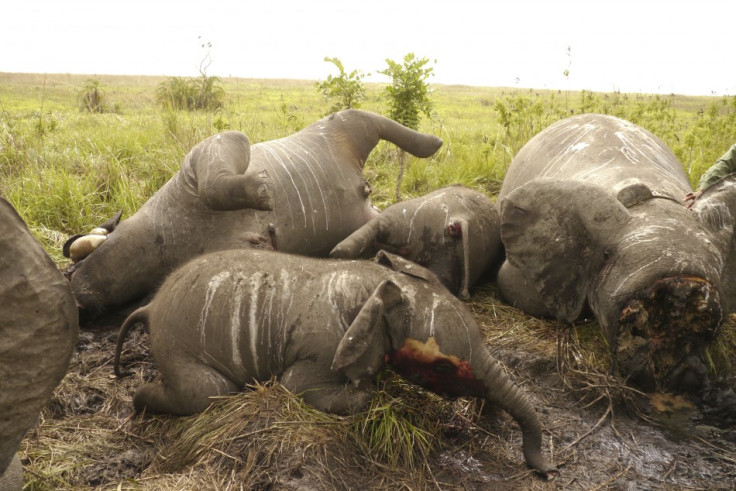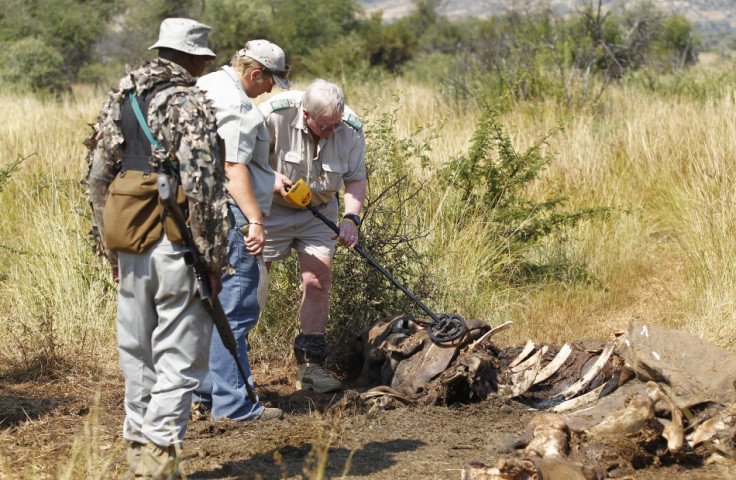Africa Witnesses Worst Poaching in DR Congo: 22 Elephants Massacred in Helicopter Attack [PHOTOS]
In a recent gruesome poaching incident in the Democratic Republic of the Congo in Central Africa, 22 elephants were killed by poachers attacking from a helicopter, in the Garamba National Park, which has been on UNESCO's list of World Heritage Sites in Danger since 1996.
According to information on UNESCO's Web site, apart from elephants, giraffes and hippopotamus other mammals in the Park include buffalo, hartebeest, kob, waterbuck, chimpanzee, olive baboon, colobus, vervet, de Brazzas and four other species of monkey, two species of otter, five species of mongoose, golden cat, leopard, lion, warthog, bush pig, roan antelope and six other antelope species. .
A Reuters' report said the poachers removed the elephants' tusks and genitals. These will then, it is believed, be smuggled to Asia through South Sudan or Uganda - the infamous Ivory Road.

This is not even the worst such incident this year.
In February, about 450 elephants were reportedly killed in the Bouba N'Djida National Park in Cameroon, in west-central Africa. The killing of these large mammals from Cameroon to Congo has raised concern about conserving African elephants, who are threatened by illegal hunting for meat and ivory.
The World Wildlife Fund (WWF) suggests that lack of proper conservation efforts may lead to the extinction of elephants in some parts of Africa within 50 years. They point to the fact elephant herds were thinned by about 80 percent, during the 1980s, in some regions.
"The African elephant once ranged across most of the African continent from the Mediterranean coast to the southern tip. It is thought there may have been as many as 3-5 million African elephants in the 1930s and 1940s," WWF mentions on its Web site.
"In the wake of intensive hunting for trophies and tusks, elephant numbers fell dramatically throughout the continent from the 1950s. In the 1980s, for example, an estimated 100,000 elephants were being killed per year," the organisation adds.
Meanwhile, research conducted by the Center for Conservation Biology at the University of Washington suggested poaching led to a more than 50 percent decline in numbers (from 1.3 million to 600,000) between 1979 and 1987.
Unfortunately, the poaching of both the African elephant and the rhinoceros is surging in many parts of Africa, including South Africa. Conservation group TRAFFIC, which monitors illegal trade in animal parts, said the growing purchasing power of emerging economies, particularly China, was creating the huge demand for these animals' meat, tusks and horns; these are used to make traditional medicines.
"China is the undisputed key to elephant conservation today," Tom Milliken, who manages TRAFFIC's Elephant Trade Information System, was quoted as saying by Reuters. Official data suggests approximately two rhinos are killed every day in South Africa to meet demand for the animal's horn, which costs $65,000 a kg, against $52,500 for a kg of gold, Reuters reported.
According to TRAFFIC, a record number of big ivory seizures were made globally in 2011, making it the worst for such seizures in over two decades. Furthermore, with the recent elephant massacres of Congo and Cameroon, it would not be preposterous to assume the trend has already continued in 2012.

MUST READ: Spider Snares, Bites & Eats Snake in Web: Incredible Footage Goes Viral [VIDEO]
© Copyright IBTimes 2025. All rights reserved.






















